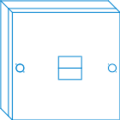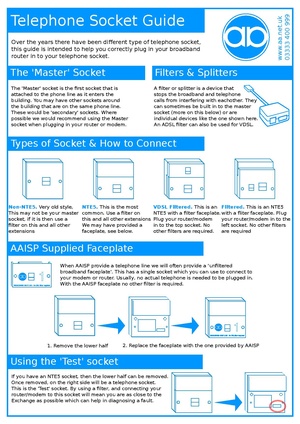Telephone Sockets: Difference between revisions
mNo edit summary |
m There's no NTE6 at the moment.... |
||
| Line 17: | Line 17: | ||
</gallery> |
</gallery> |
||
=== |
===NTE5C=== |
||
BT started using the NTE5C sockets in 2016, by October 2016 most new phone line installations were with this new style. The socket is curved rather than flat on the front face, and the lower section can be removed by simply un-clipping it - there are no longer screws holding the cover in place. There is still a test socket under the lower section. |
BT started using the NTE5C sockets in 2016, by October 2016 most new phone line installations were with this new style. The socket is curved rather than flat on the front face, and the lower section can be removed by simply un-clipping it - there are no longer screws holding the cover in place. There is still a test socket under the lower section. |
||
Revision as of 17:03, 9 November 2016
There are various styles of telephone socket, most are "NTE5". This page aims to explain the various forms of this socket. NTE stands for 'Network Termination Equipment', 5 relates to the version number.
Socket Overview
-
NTE5c (2016)
-
NTE5c cover removed
-
Non-NTE5
-
NTE5
-
NTE5 Open
-
Filtered VDSL Faceplate
-
Filtered Service Specific Faceplate
-
Unfiltered Broadband Faceplate (Removed)
-
Unfiltered Broadband Faceplate (AAISP Branded)
-
Unfiltered Broadband Faceplate (Installed)
-
Filter
NTE5C
BT started using the NTE5C sockets in 2016, by October 2016 most new phone line installations were with this new style. The socket is curved rather than flat on the front face, and the lower section can be removed by simply un-clipping it - there are no longer screws holding the cover in place. There is still a test socket under the lower section.
Non-NTE5
This socket could be an old style master socket, or it could be a secondary socket. Openreach should not be installing this style of socket as the master socket when installing a new phone line.
NTE5
This is the 'standard' socket that Openreach will install, it has been the standard since the 1980's. The lower half is removable. Removing the lower half gives access to the 'Test Socket' as well as the connectors.
VDSL Faceplate
With an engineer installed FTTC (aka VDSL, BT Infinity) a VDSL faceplate is sometimes installed. The socket at the top is a RJ11 socket and should be connected to the FTTC modem or router. The Lower socket is a BT telephone socket for a phone to connect to.
Service Specific Faceplate
Unfiltered Broadband Faceplate (Installed)
This NTE5 has been fitted with an unfiltered RJ11 socket. These faceplates are typically supplied by AAISP if they provide the phone line where no phone calls are provided. The socket is an RJ11 and so a router can be connected without the need for a filter/splitter.











